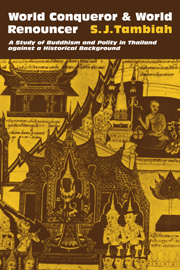 World Conqueror and World Renouncer
World Conqueror and World Renouncer Published online by Cambridge University Press: 10 November 2010
Bishop Pallegoix, whose two-volume Description du Royaume Thai ou Siam was published in 1854, informs us that he had spent 24 years in the kingdom of Siam. It is therefore almost certain that his observations relate primarily to the reign of Rama III (1824–1851). Being a Catholic missionary he may have exaggerated the “laxness” of the Siamese phra; nevertheless, his information on the structure of the sangha and its linkage with kingship is invaluable.
Certain important points emerge from his account, parts of which are quoted below: firstly, that there was a sangha hierarchy, headed by the sangkharat and below whom were the titled abbots of royal monasteries flanked by their assistants and secretaries; secondly, that in fact the authority and powers vested in the sangkharat were circumscribed; next, that it is by contrast the king who was the crucial fountain of authority and source of titles in his position as protector and patron of the religion; and, finally, that the department of ecclesiastical administration (Krom Dharmakara/Thammakan), which we have already identified as being part of the machinery of state administration in the Ayutthayan era, was probably actively functioning around the mid-nineteenth century as an adjudicator of monastic crimes, enforcer of monastic discipline, and as keeper of registers of monasteries and their residents, religious and lay.
To save this book to your Kindle, first ensure [email protected] is added to your Approved Personal Document E-mail List under your Personal Document Settings on the Manage Your Content and Devices page of your Amazon account. Then enter the ‘name’ part of your Kindle email address below. Find out more about saving to your Kindle.
Note you can select to save to either the @free.kindle.com or @kindle.com variations. ‘@free.kindle.com’ emails are free but can only be saved to your device when it is connected to wi-fi. ‘@kindle.com’ emails can be delivered even when you are not connected to wi-fi, but note that service fees apply.
Find out more about the Kindle Personal Document Service.
To save content items to your account, please confirm that you agree to abide by our usage policies. If this is the first time you use this feature, you will be asked to authorise Cambridge Core to connect with your account. Find out more about saving content to Dropbox.
To save content items to your account, please confirm that you agree to abide by our usage policies. If this is the first time you use this feature, you will be asked to authorise Cambridge Core to connect with your account. Find out more about saving content to Google Drive.